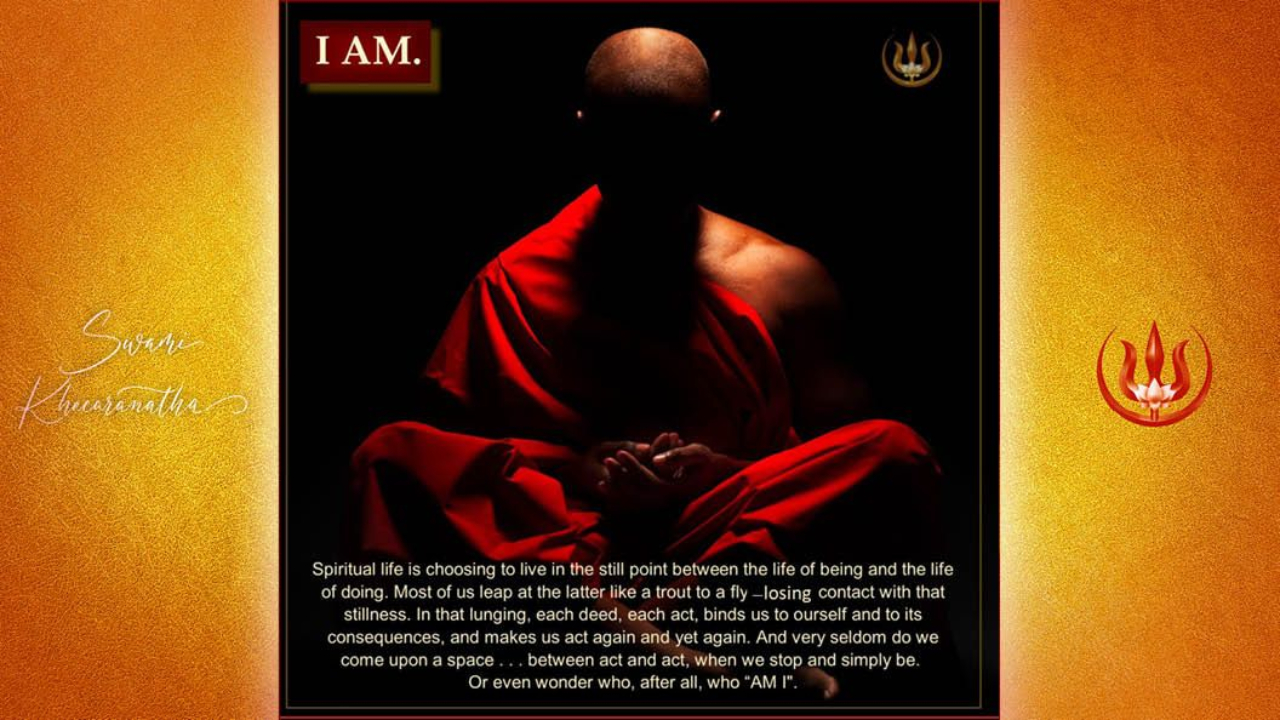The Power of Dynamic Stillness

We often find ourselves in a constant state of doing. We rush to act, and each deed binds us to our limited self-identity and to the act’s consequences — a cycle that keeps repeating itself. Stuck in this loop, we forget to ask, “Who am I?” We also may forget that we can make contact with the space between being and doing where we can simply be.
Having a spiritual life means choosing to live in this still point between the life of being and the life of doing — a place in which being and acting happen simultaneously without colliding or causing a ripple in the other. In Tantric Śaivism, this is called “dynamic stillness,” and within that is spanda, the subtle pulsation of the breath of God. Spanda is the almost imperceptible movement of Consciousness into form. You can also think of it as śakti (energy) expressing itself as the pulsation of pure Consciousness.
Picture a lava lamp — a transparent rectangular plexiglass box filled with blue and clear liquid that cannot mix. The lamp rocks gently back and forth on a fulcrum, creating simulated waves, but there is a still point between the end of one wave and the beginning of the next. Like that, in us, there is a still point between action and silence that is almost imperceptible. An important element of our sādhana is to make contact with this moment of dynamic stillness.
Coming Back to Center
Through our sādhana, we practice and hone our ability to connect to and function from this place of pure, profound awareness. Remaining in this place of pure Consciousness, of dynamic stillness, is a way to experience our own being, as well as the pure joy of that being. Our sādhana is the discipline of being and acting at the same time without losing contact with that still point.
We want to be like Śiva, whose mantra is “I am” (Aham). Within that “I am” is the arising and subsiding of the sound of pure Consciousness, which always knows Itself as that Consciousness. Śiva doesn’t need to ask “Who am I?” because He knows Himself to be all things. He is pure Awareness, acting, creating, manifesting, and expressing Himself as Himself.
Even as we are engaged in action, we should seek to understand that Śiva is really the actor. Śiva is the dancer, the doer. He is acting as us, dancing as us, from that place of dynamic stillness. Although Śiva never has to ask, “Who am I?” we must do so to help remind us to regain contact with the stillness rather than remain perpetually caught in action. It is only in that contact that we become aware that we were never the doer!
Acting from Stillness
Acting from a place of dynamic stillness, we begin to truly understand that our experience of duality happens within unity. We learn that there is no distinction between Consciousness and the action of that Consciousness; no distinction between our consciousness and that of Śiva, who is repeating “I am.”
What we typically do is act, again and again, and by getting caught in our actions we forget who we are. That is why we need to interrupt this cycle, stop, and ask, Who am I? — and if the response is I am an individual who is separate from Śiva, then we must tune back inside to regain contact with a deeper awareness.
Stillness of action doesn’t mean not acting. It means to act from pure Consciousness. In our sādhana, we aim to establish ourselves in this dynamic stillness and remain there. This allows us to free ourselves from the distinction between being and action. The purpose of action is knowledge, which means that all of our actions should help bring us to a deeper knowledge of ourselves. This cannot happen if we are losing ourselves in our actions.
Maintaining Contact as Śakti Builds
The gift of nondual practices is the knowledge and experience that we are not separate from the world. In our meditation we make contact with pure Consiousness, and then, as we engage our daily life, we maintain that contact while we are doing. Otherwise, it’s all too easy to veer off course, forget who we are, and even neglect to look for a deeper awareness.
Consciousness is always just a breath away if we are aware of the place from which that breath arises and subsides. We can also be aware of the source of our thoughts.
In the pulsation of Consciousness there is always a still point between the end of one wave and the beginning of another. Established in that dynamic stillness, we can always choose to act from a place of pure Consciousness, rather than from our tensions and patterns. So before you act, take a breath. Make contact with that still point and act from there.
As we progress in our sādhana, there is an exponential increase in the śakti within us. We use that intensity to fold our awareness back inside itself and then maintain that contact throughout the day. This is how we become disciplined about acting from stillness. Then, if we ask the question, “Who am I?” we discover that the answer is this: we are the simple joy of being.
